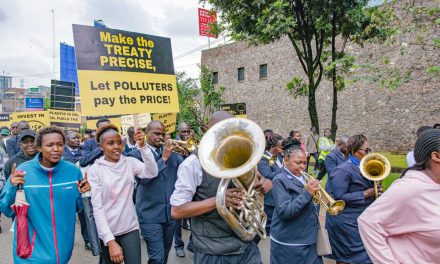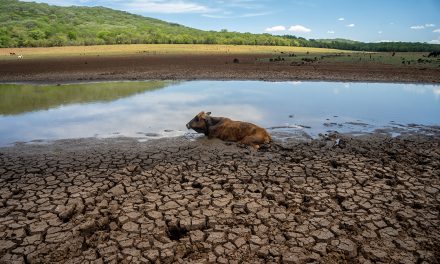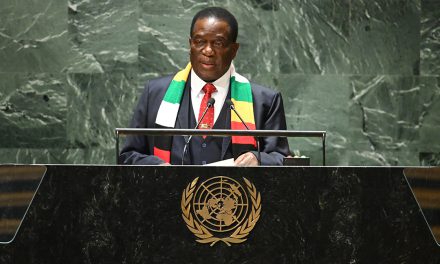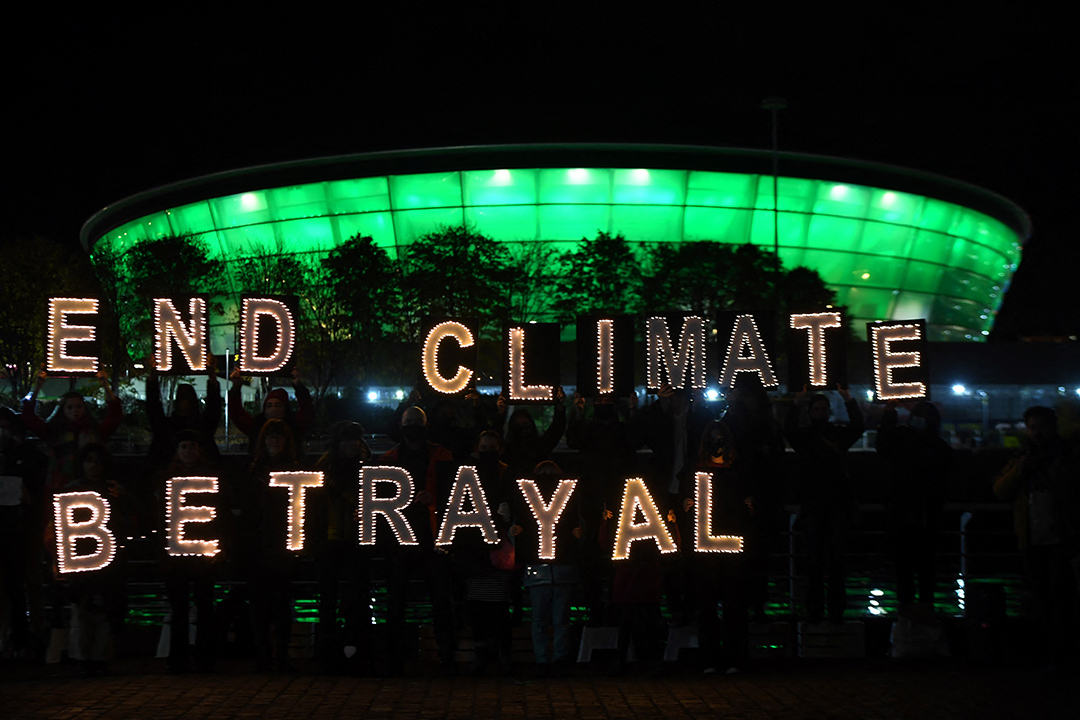
Climate youth activists hold up illuminated letters spelling out “End Climate Betrayal” in Glasgow, Scotland on November 2, 2021, during the COP26 UN Climate Change Conference. Photo: Andy Buchanan/AFP
On 12 November 2021, the United Nations 26th Annual Climate Summit (COP26) concluded in Glasgow with a series of new commitments and pledges signed to address the global climate crisis. Despite this, Africa, the continent most affected by climate change, failed to secure several key demands outlined by the African Group of Negotiators (AGN). In particular, questions around international climate finance for adaptation, and how climate finance is distributed among developing and least developed nations, remained unanswered.
Furthermore, issues regarding climate justice for historical emissions and who ultimately bears responsibility for the climate crisis remain largely unresolved. Africa contributes less than 4% of the world’s total emissions but bears a highly disproportionate brunt of the negative impact thereof. Developed countries must, therefore, provide sufficient financial support to the continent to alleviate the costs of adaptation to a problem the continent did not create.
New commitments and renewed pledges
COP26 concluded with parties to the United Nations Framework Convention on Climate Change (UNFCCC) adopting the Glasgow Climate Pact (GCP). Four of the more notable takeaways from the Pact include the following:
- For the first time since the beginning of the UNFCCC process, which began with the signing of the Kyoto protocol in 1995, the Glasgow Climate Pact makes direct reference to “phasing down” the use of coal and “phasing out” inefficient fossil fuel subsidies.
- The Pact “urges” developed countries to scale up on their collective provision of climate change finance for adaptation to developing countries and deliver on the 2009 $100 billion pledge urgently and through 2025.
- The Pact “reaffirms” the Paris Agreement goal of holding the increase in global average temperature to well below 2°C above pre-industrial levels, preferably to 1.5°C, given the strong scientific indications that anything above 2 will result in climate catastrophe.
- The Pact urged countries to provide more ambitious Nationally Determined Contributions (NDCs) in 2022, instead of following the traditional five-year interval for NDC submissions. This opens the door to ratcheting up climate commitments on an annual basis.
Aside from the Glasgow Climate Pact, several important deals and new commitments were made during the Summit:
- The Just Transition Partnership Deal was signed between South Africa and Germany, France, the United Kingdom (UK), the United States (US), and European Union (EU). The deal will provide SA with $8.5 billion in funding to assist in the country’s transition to renewable energy sources.
- Over 100 nations signed the Global Forests Pledge, which outlines the intention to end deforestation by 2030. Part of the pledge includes a $1.5 billion fund backed by the European Union (EU) and the UK to protect and restore the Congo Basin.
- 105 nations signed onto the Global Methane Pledge, which calls on states to cut methane emissions by 30% by 2030.
- China and the US issued a joint declaration outlining their mutual intention to cooperate over the next decade on a range of climate action points, including the reduction of methane emissions.
- The Global Energy Alliance (GEA), a group of philanthropic foundations and international development banks, announced the launch of a $10.5 billion fund to help emerging economies with growing energy needs make the switch from fossil fuels to renewable sources. Crucial incentives are needed to speed up investment and funding to a low carbon future. Many economists recommend that this be accompanied by production taxes that will deal with dirty emissions and shift the burden to those who benefit from creating them.
While the above commitments do reflect important progress made, with the agreed phase-down of coal, methane pledge, and Just Transition Partnership Deal being most notable, the African Group of Negotiators (AGN) failed to make progress on some key demands.
Failures
Between 2016 and 2019, developed countries committed to mobilising $100 billion per year in international climate finance to assist developing nations deal with climate change. However, the highest annual contribution met was $80 billion in 2019. Of this amount, Africa received only 26% of these funds despite suffering the highest burden from climate impacts and having the highest needs when it comes to transitioning to green energy. According to the African Development Bank report, for Africa to implement its adaptation plans by 2030, it requires $3 trillion, and $240 billion to transition to cleaner energy far from the money it has received thus far. As multiple studies show, even with the potential to double international climate funding to $200 billion per annum, this is still nowhere near enough to meet the continent’s actual needs. The chair of the AGN, Tanguy Gahouma-Bekale, called for developed nations to commit to a $700 billion a year finance deal from 2025 to accelerate decarbonisation and adaptation efforts. This was ignored.
Not only have there been challenges associated with raising climate funding, but also with its distribution. There is a clear imbalance between funding towards mitigation and funding for adaptation, which the summit failed to address. As Figure 1 below illustrates, the majority of international climate finance to date has gone towards mitigation (efforts to reduce global greenhouse gas emissions) over adaptation (adapting to the current or future negative impacts of climate change). One challenge is that the definition of what should be considered finance for ‘adaptation’ differs between developing and least developed countries. Second, while intended provisions are in place to ensure 50% of climate finance goes towards adaptation, failure to meet this mark has been unaddressed since 2015’s Paris Agreement and remained so at COP26. In addition, the 50/50 commitment further marginalises poorer countries with low carbon emissions, where the priority is adaptation. COP26 did not show signs of progress towards a more balanced needs assessment (providing more funding for adaptation projects in countries vulnerable to climate impacts and provide more mitigation funding for high-emitting countries) for international climate finance, where an individual country’s needs and priorities are addressed.

The Summit also failed to address inequalities in how international climate finance is dispersed between developing and least developed nations, and the form which this financing should take. Most of the mobilised finances were dispersed to countries with stronger financial capabilities of their own such as South Africa and not the poorest countries. South Africa is one of the countries in Africa whose communities are dependent on coal mining and will most likely suffer from a transition to a low carbon economy in the absence of economic regeneration. The least developed countries appear to have higher levels of investment risk, hence the lack of investment opportunities. Developed countries invest in countries where their capital has higher return prospects. Climate inequalities in Africa are then further deepened by private financing going to even fewer poor countries.
Even with the commitments made at COP26, the progress is still insufficient for Africa to transition more quickly. The summit failed to address one complex issue, namely, the form (grants or loans) in which the money is to be received. Between 2016 and 2019, most of the public climate finance came from loans. Of the $60 billion in public finance provided during this period, $44 billion consisted of loans [See Figure below]. This further indebts poorer nations who often end up getting penalised if they default on loan repayments.
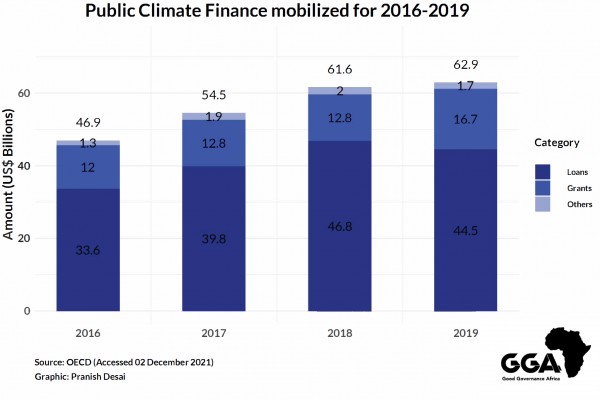
Despite the acknowledgment of loss, costs, and damages caused by climate change at COP26, developed countries still refuse to officially acknowledge historical responsibility for loss and damage costs. For countries that are witnessing the devastating impacts from sea level rises and cannot afford sea-level rise adaption strategies, the failure to secure a dedicated damage fund is equivalent to no action. To date, Scotland and philanthropic organisations have offered some financial support towards the loss and damage costs. Developed countries have largely refused to compensate, however, and are reluctant to act further. Hopefully, progress will be made in addressing this at next year’s COP which is to be held in Egypt. The pact agreeing to fund the Santiago Network, which is aimed at advancing the work on loss and damage, is a step in the right direction.
Climate change catastrophe is evidently on the horizon if the world does not act. Costly as such action might be in the short run for individual nations, it is imperative that they be incurred for the sake of maintaining a planet that is capable of producing any kind of shared future prosperity. Collective action remains the Achilles Heel, and all stakeholders have to do more to ensure appropriate adaptation funding for the worst-affected (and least polluting) African countries. Moreover, governments have to work harder to apply an appropriate policy mix of incentives to switch from dirty to clean technologies and credible deterrents for those who attempt to pursue the status quo.
Leleti Maluleke is a Researcher for our Human Security and Climate Change programme. She completed her Bachelor of Political Science in Political Studies in 2017, and her Honours in International Relations in 2018 at the University of Pretoria. She started her career at International SOS in the Security Services department as a Political Risk and Security Intern. Socially, her countries of interests include Mozambique, Zimbabwe, Zambia and Malawi.


